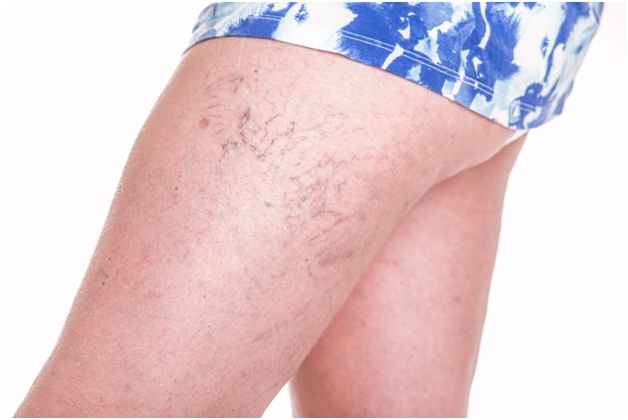Telangiectatic matting is a diffuse area of very fine “spider” veins that start to grow in an area after injury or after varicose vein treatment. Telangiectatic matting is a known side effect of sclerotherapy but can also develop after other types of varicose vein treatment as well. They often go away on their own but may get worse, especially if there is an active vein feeding the area with blood.
Although telangiectatic matting is almost always non-painful, it can be aesthetically displeasing, and in can in rare cases, cause more serious problems. Luckily, in most people, this ugly matting will “spontaneously” disappear if the patient is patient and doesn’t mind living with it for several months (usually it disappears within six months) while their own body slowly repairs it.
Multiple Sclerotherapy Treatments May Lead To More Matting
It is known among vein doctors that performing more than one sclerotherapy treatment on a patient over a short time increases the odds of telangiectatic matting occurring. No one knows for sure why but it is likely due to the additional exposure of the same veins to the chemical used to ablate the vein, i.e. the sclerosant. This is especially true if the vein doctor uses a stronger sclerosant or uses a lot of it so that it penetrates surrounding veins that are not the target of the varicose vein treatment to some degree.
Technique Matters!
Everyone undergoing sclerotherapy varicose vein treatment has a chance of developing telangiectatic matting around the site of the injection(s). However, it seems that the odds go down dramatically if you receive treatment from a vein doctor who is particularly skilled in this technique.
For example, if there is too much pressure applied to the treated varicose vein, most vein doctors now believe this increases the chance of telangiectatic matting. Another example is if the sclerosant (the chemical used in the injection) is too strong. So, it is always best to look for a vein doctor with a great deal of experience and an exceptionally good reputation, such as those you find at Metro Vein Centers. You want the best skilled hands you can find to perform your sclerotherapy varicose vein treatment.
Is Telangiectatic Matting Permanent?
In most cases, telangiectatic matting will slowly fade away, although it can take up to several months to a year to do so. However, in some cases, telangiectatic matting may be permanent. Depending on who your doctor is, and your own wishes, additional sclerotherapy sessions after your initial sclerotherapy treatment can sometimes get rid of the telangiectatic matting you see, or at least make it fade substantially. Intense pulsed light therapy (IPL) is also sometimes used to eliminate telangiectatic matting.
Before your vein doctor gives you additional sclerotherapy varicose vein treatment, he or she will need to look for the root cause of the telangiectatic matting. For example, as mentioned above, a feeder vein with a faulty vein valve, may be contributing to the telangiectatic matting. If this is the case, your vein doctor may recommend treating this feeder vein with another sclerotherapy session, rather than the telangiectatic matting itself.
To look for these possibilities, your vein doctor will perform additional duplex ultrasound and or transillumination. The latter is a technique that shines a bright light through the skin to see the veins inside! Either way, identifying the problem is more than half the battle is solving the problem and in making telangiectatic matting go away permanently.
Some People Are Just More Genetically Prone To Telangiectatic Matting
Some people are genetically predisposed to developing telangiectatic matting, regardless of technique, after certain types of varicose vein treatment. For example, if telangiectatic matting runs in your family, you should mention this to your vein doctor as you will have a higher risk of developing it.
In a paper entitled, “Telangiectatic Matting is Associated with Hypersensitivity and a Bleeding Tendency,” published this year (2018) in the European Journal of Vascular and Endovascular Surgery, the authors present evidence that people who have a tendency to bleed more, bruise more, and have hypersensitivity (examples: hay fever, eczema, rhinitis, etc) are more likely to develop telangiectatic matting after varicose vein treatment. This is pure genetics, just like some people are more prone to gaining weight.
You’ll Be In Good Hands At Metro Vein Centers
To avoid complications, like telangiectatic matting, or at least minimize the odds of this happening, you’ll want to find the best vein doctor and varicose vein treatment clinic you can find! One of the best vein clinics in the business is Metro Vein Centers. They have staff and vein doctors who have been specializing in this type of varicose vein treatment for years, even decades, and they keep current with all the latest advances. You can get a free evaluation of your veins just by calling one of Metro Vein Centers’ many locations and setting up an appointment.

